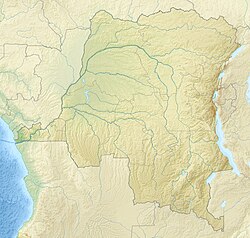| Lofoi Falls | |
|---|---|
 | |
 | |
| Location | Kundelungu National Park, Katanga Province, Democratic Republic of the Congo |
| Coordinates | 10°15′37″S27°36′24″E / 10.26028°S 27.60667°E |
| Total height | 340 metres (1,120 ft) |
| Watercourse | Lufira River |
The Lofoi Falls (also known as the Chutes Kaloba and the Chutes Lofoi) is a waterfall in Kundelungu National Park, Katanga Province, Democratic Republic of the Congo. Plunging down for an unbroken 340 m, it is one of the largest waterfalls in Central Africa. [1] The waters of the Lofoi are a tributary of the Lufira River. [1] The falls shrink quite a bit during the drier season of June to October, but are quite dramatic during the rest of the year. [2]
